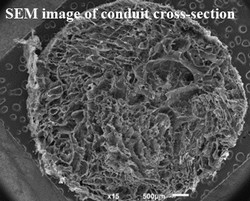New hope for spinal cord injuries
In Europe, there are approximately 330 000 people living with spinal cord injuries and more than 11 000 new cases annually. Injuries and degenerative diseases of the central nervous system constitute a bottleneck in medical and surgical practice, and no therapy currently exists. Treatment and rehabilitation or other healthcare costs mount to billions of euros, necessitating novel solutions to address these medical challenges. The scope of the EU-funded project NEUROGRAFT(opens in new window) (Development of functionalised cell seeded bioartificial organ for transplantation in nerve repair) was to develop a bioartificial organ that could be used for the regeneration of spinal cord. Towards this goal, scientists proposed fabricating a conduit system loaded with anti-inflammatory agents and stem cells that would aid functional regeneration following spinal cord injury. Following extensive optimisation, the NEUROGRAFT conduit was made out of collagen and had the capacity to incorporate and release a bioactive anti-inflammatory component. Interleukin-37 and interleukin-10 were proposed as potent immunomodulatory molecules that could shape the initial inflammatory responses and increase the survival and therapeutic efficacy of transplanted mesenchymal stem cells. The latter were obtained from adipose tissue to clinical grade and demonstrated effective differentiation down the neuronal lineage. The fabricated conduit supported the differentiation of mesenchymal stem cells into functional neurons in vitro and generated promising results when transplanted in vivo in rat models of spinal cord injury and paraplegia. Importantly, it showed no adverse degradation, cytotoxicity, genotoxicity or systemic toxicity side-effects. Furthermore, scientists envisioned the incorporation of potent neuroregulatory molecules for enhanced functional nerve regeneration in the central nervous system. Considering there is no comparable product on the market, the NEUROGRAFT conduit system constitutes an innovation. The participating small and medium-sized enterprises successfully developed a human-scale device under good manufacturing practice conditions that could be commercialised in the future. Overall, a therapeutic intervention for spinal cord injury, where functionality of neuronal tissue is re-established through the use of stem cells, would have an invaluable socioeconomic impact.







